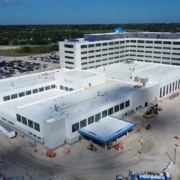Protecting Tampa’s Hospitals from Lightning Disruptions
Imagine the steady beep of a heart monitor in a Tampa operating room. A surgeon’s hands are steady, focused on a life-saving procedure. Then, a summer storm rolls in. The sky darkens, and a sudden, powerful surge of electricity strikes nearby. In an instant, that critical monitor could go dark. The life it tracks hangs in the balance.
This isn’t a scene from a movie. It’s a real and present danger for medical centers across Florida. Our region faces some of the most intense electrical storms in the nation. For healthcare facilities, this environmental reality creates an unparalleled responsibility. The well-being of patients and staff depends on uninterrupted power and fully functional technology.
Modern medicine relies on a complex network of sensitive electronics. From MRI machines to climate control, these systems are the backbone of patient care. A single electrical surge can cripple this vital infrastructure. The consequences extend far beyond damaged equipment, directly impacting the safety and continuity of medical services that our community depends on every day.
Key Takeaways
- Tampa’s geographic location makes its healthcare facilities exceptionally vulnerable to electrical storms.
- Continuous operation is non-negotiable for medical centers, where lives depend on the functionality of technology.
- Advanced medical equipment is highly susceptible to damage from power surges caused by nearby strikes.
- Preventing disruptions through robust safety measures is far more effective than managing an emergency evacuation.
- A comprehensive safety strategy is crucial for balancing regulatory requirements with the need for uninterrupted patient care.
Understanding Lightning Risks in Healthcare Facilities

Advanced diagnostic machines and life-support systems operate with precision that electrical disturbances can instantly compromise. These sophisticated technologies form the backbone of modern medical treatment, yet remain highly vulnerable to power anomalies.
The consequences extend beyond immediate equipment failure. Subtle component degradation can occur, creating hidden risks that manifest during critical procedures.
Impact on Medical Equipment and Patient Care
Electrical surges pose significant threats to essential healthcare technology. Sensitive electronics in monitoring devices and diagnostic equipment suffer the most severe damage.
This vulnerability directly impacts patient safety. When critical systems fail, treatment continuity becomes compromised, creating dangerous situations for those receiving care.
| Equipment Type | Vulnerability Level | Potential Impact | Recovery Time |
|---|---|---|---|
| MRI/Imaging Systems | High | Diagnostic delays | Weeks to months |
| Patient Monitors | Critical | Immediate safety risk | Hours to days |
| Ventilators | Critical | Life-threatening | Immediate replacement needed |
| Communication Systems | Medium | Coordination breakdown | Days |
Real-World Case Studies and Incidents
A 2017 incident at a Florida trauma center demonstrates the catastrophic potential. A single strike caused complete power loss during hurricane preparations.
Backup systems failed, leaving 225 individuals without essential services. The event required massive emergency evacuation efforts.
Smaller practices face similar dangers. Dental offices and clinics have experienced complete destruction from electrical events, displacing thousands of active patients.
Regulatory Standards and Risk Assessments in Hospital Environments

A hospital’s ability to withstand environmental threats begins with rigorous compliance protocols. Medical centers must adhere to specific safety standards that govern their infrastructure. These regulations ensure continuous operation during severe weather events.
The FGI Guidelines for Design and Construction mandate comprehensive safety risk assessments for all projects. This process requires an interdisciplinary team approach. Facilities must evaluate multiple safety domains simultaneously.
NFPA 780 and FGI Guidelines for Safety
NFPA 780 provides the authoritative standard for installation protocols. Its Annex L contains specific risk assessment procedures for healthcare settings. These calculations consider local lightning density and building characteristics.
Tampa’s position in Florida’s “lightning alley” significantly elevates risk scores. This often makes protective systems essential rather than optional. The standards satisfy Medicare, Medicaid, and Florida Building Code requirements.
Conducting Comprehensive Risk Assessments
A thorough evaluation examines structure height, construction materials, and occupancy. It also assesses the consequences of service interruption. The need to maintain critical operations increases vulnerability scores.
Documentation becomes part of facility accreditation and emergency planning. Administrators must reassess risks during expansions or system upgrades. This ongoing process ensures continuous compliance with evolving standards.
Implementing Robust Lightning Protection Systems
A properly installed safety network transforms vulnerable structures into shielded environments capable of withstanding nature’s forces. This approach requires integrating multiple components that work together seamlessly.
The architecture creates safe pathways from rooftop elements to ground electrodes. This design prevents dangerous currents from affecting sensitive medical technology.
Installation Best Practices and System Integrity
Certified specialists follow strict protocols during implementation. They position air terminals using proven methods for complete coverage.
All metallic components must connect to achieve electrical equilibrium. This bonding prevents potential differences that could damage vital equipment.
Regular inspections ensure ongoing reliability. Documentation from third-party verification supports regulatory compliance and insurance requirements.
Innovative designs can blend safety with aesthetics. Some facilities incorporate functional elements that serve dual purposes while maintaining full protection.
Lightning Protection for Hospitals
Zone-based safety architecture represents the gold standard in safeguarding critical healthcare infrastructure. This methodology divides medical facilities into progressively protected areas, each with specific defense requirements.
Key Components and Industry-Recognized Standards
External safety zones encompass rooftop areas and exterior structures where direct electrical attachment risks are highest. These areas require robust air-terminal networks and properly spaced down conductor systems.
Internal zones protect sensitive interior spaces like operating rooms and intensive care units. Layered surge protection devices and electromagnetic shielding progressively attenuate transient overvoltages.
Industry standards including IEC 62305 and NFPA 780 provide the technical framework for comprehensive safety system design. These guidelines specify component spacing, conductor sizing, and bonding requirements.
Equipotential bonding systems intentionally interconnect all conductive building elements. This approach eliminates dangerous potential differences during electrical events. Foundation grounding systems provide essential earth interfaces for current dissipation.
Ensuring Surge Protection and Infrastructure Safety
A layered approach to power quality management is essential for safeguarding medical infrastructure. This strategy addresses both external atmospheric events and internal electrical disturbances that threaten sensitive equipment.
Protecting Sensitive Electrical Systems and Equipment
Modern medical centers face dual surge threats. External atmospheric events account for approximately 20% of transient voltage incidents. The remaining 80% originate internally from facility equipment operations.
Sensitive electronic systems require comprehensive defense strategies. Imaging equipment, patient monitors, and building automation controllers are particularly vulnerable. Proper safeguards prevent catastrophic failures during critical procedures.
Coordinated Use of Surge Protective Devices
The three-stage protection principle forms the foundation of effective surge mitigation. Type 1 devices install at main service entrances to intercept major electrical events.
Type 2 units protect sub-distribution panels serving specific departments. Type 3 devices provide final protection at individual equipment terminals. This cascaded approach progressively limits overvoltages to safe levels.
Coordinated selection ensures seamless operation between protection stages. Proper voltage ratings and discharge capacities create comprehensive coverage without vulnerable gaps.
Innovative Technologies and Evolving Protection Solutions
Modern surge protection technology has entered a new era of intelligent design and modular flexibility. These advanced systems offer Tampa medical centers superior safety with easier installation and maintenance.
Space-saving designs address chronic constraints in electrical rooms. Some devices measure just 6mm wide while delivering full performance.
Advanced Surge Arresters and Modular Systems
Modular architectures revolutionize maintenance procedures. Plug-in protection modules enable rapid replacement without system shutdown.
Intelligent status indicators provide real-time health monitoring. Facilities teams receive immediate alerts about compromised devices.
| Product | Application | Key Feature | Width | Compliance |
|---|---|---|---|---|
| BLITZDUCTORconnect | Signal interfaces | Push-in connection | 6mm | NFPA 780 |
| DEHNguard MU 3PY | 3-Phase systems | Pluggable modules | DIN rail | NFPA 780 |
| DEHNpatch Class EA | Network systems | RJ45 connection | 19mm | NFPA 780 |
| DEHNgate | Video systems | BNC socket | Support rail | NFPA 780 |
Specialized devices protect medical imaging and building automation networks. Each application receives optimized electrical parameters.
High-voltage-resistant conductors allow safer routing in constrained spaces. This advancement reduces side-flash risks near sensitive equipment.
Customized Strategies for Tampa’s Healthcare Facilities
Healthcare administrators in the Tampa Bay area face environmental challenges unlike any other region in the United States. The area’s position within Florida’s “lightning alley” creates unique demands for medical centers of all sizes.
Regional Considerations and Tailored Approaches
Tampa’s high ground flash density requires specialized safety planning. The Florida Building Code includes specific requirements for medical buildings.
Coastal corrosion factors affect grounding systems differently here. Hurricane season compounds electrical risks with extended severe weather events.
Small clinics and large medical centers need scalable approaches. Each facility’s size and service criticality determine appropriate safety measures.
Collaboration with Certified Lightning Protection Specialists
Working with certified specialists ensures proper system design and installation. These experts understand Florida’s unique regulatory landscape.
Staff training programs must address safety protocols during electrical activity. Maintenance procedures should preserve system integrity during rooftop work.
Patient discharge protocols during nearby strikes follow National Weather Service guidance. This comprehensive approach safeguards medical operations.
Conclusion
When severe weather threatens Tampa, healthcare facilities must remain operational sanctuaries for vulnerable patients. This commitment goes beyond basic compliance, representing a fundamental investment in community health.
Comprehensive safety measures integrate external defense systems with coordinated internal safeguards. These work together to shield critical medical equipment and essential infrastructure from electrical events.
Tampa medical centers that implement robust strategies demonstrate true operational excellence. They ensure uninterrupted patient care during the region’s frequent storm activity.
Collaboration with certified specialists and adherence to recognized standards creates resilient environments. This proactive approach safeguards healing missions when weather conditions intensify outside.












